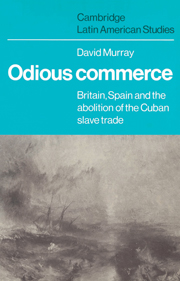Book contents
- Frontmatter
- Contents
- Tables
- Preface
- 1 The ‘opening’ of a legal trade
- 2 Parliament versus Cortes
- 3 Legality and illegality
- 4 The treaty of 1817
- 5 Enforcement and re-enforcement: the attempt to make the slave trade prohibition effective
- 6 The treaty of 1835
- 7 An abolitionist era
- 8 The Turnbull affair
- 9 The Escalera conspiracy
- 10 The penal law of 1845
- 11 Free trade and annexationism
- 12 The failure of the penal law
- 13 A new class of slaves
- 14 The abolition of the Cuban slave trade
- Abbreviations
- Notes
- Bibliography
- Index
- CAMBRIDGE LATIN AMERICAN STUDIES
4 - The treaty of 1817
Published online by Cambridge University Press: 16 October 2009
- Frontmatter
- Contents
- Tables
- Preface
- 1 The ‘opening’ of a legal trade
- 2 Parliament versus Cortes
- 3 Legality and illegality
- 4 The treaty of 1817
- 5 Enforcement and re-enforcement: the attempt to make the slave trade prohibition effective
- 6 The treaty of 1835
- 7 An abolitionist era
- 8 The Turnbull affair
- 9 The Escalera conspiracy
- 10 The penal law of 1845
- 11 Free trade and annexationism
- 12 The failure of the penal law
- 13 A new class of slaves
- 14 The abolition of the Cuban slave trade
- Abbreviations
- Notes
- Bibliography
- Index
- CAMBRIDGE LATIN AMERICAN STUDIES
Summary
The Congress of Vienna and Spanish abolition
After Britain's behind-the-scenes role in the Cortes debate of 1811, the British government took no further diplomatic action to persuade Spain to abolish the slave trade until 1814. By then the war was over and British abolitionists were leading a feverish agitation against the slave trade. Their chief aim in the spring of 1814 was to persuade the European powers to agree on a convention to prohibit the slave trade. In a letter to James Stephen on 18 April, Wilberforce summed up his attitude to the Spanish and Portuguese slave trade: ‘It happens quite providentially that the only powers which are interested in carrying the Slave Trade on, are Spain and Portugal, and they may surely be compelled into assent.’
The campaign focussed on the task of preventing the revival of the French slave trade. When the abolitionists discovered that in the treaty of peace with France all France's colonies were returned to her in exchange for a promise to give up the slave trade in five years, they were bitterly disappointed. Redoubling their efforts, they roused public opinion in the country and were the instrumental force behind the overwhelming flow of petitions to the House of Commons which protested against the revival of the French slave trade. In thirty-four days beginning 27 June 1814, the House of Commons received 772 petitions with nearly one million signatures. As Webster says, ‘the subject was one in which almost the whole nation had become interested. It could not be ignored’.
- Type
- Chapter
- Information
- Odious CommerceBritain, Spain and the Abolition of the Cuban Slave Trade, pp. 50 - 71Publisher: Cambridge University PressPrint publication year: 1981



